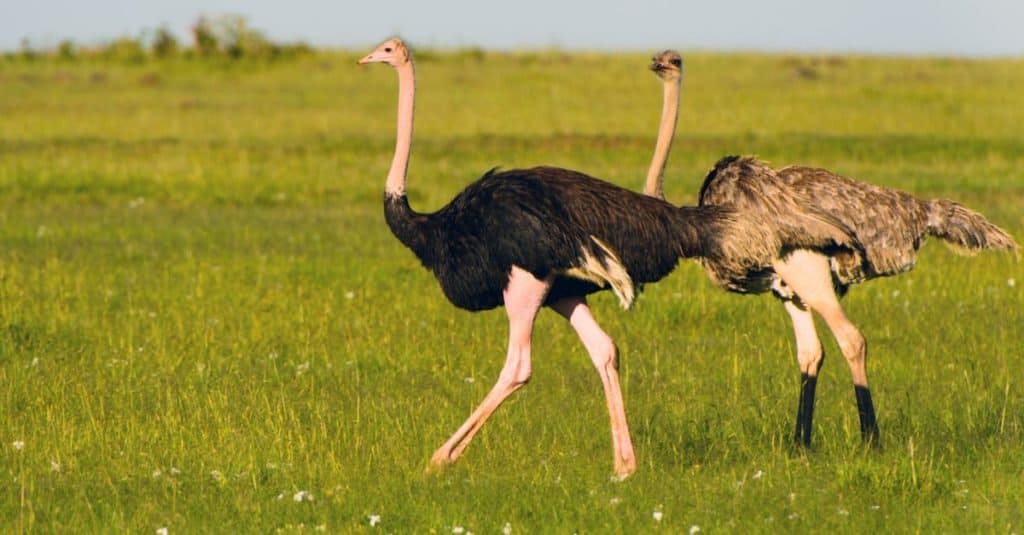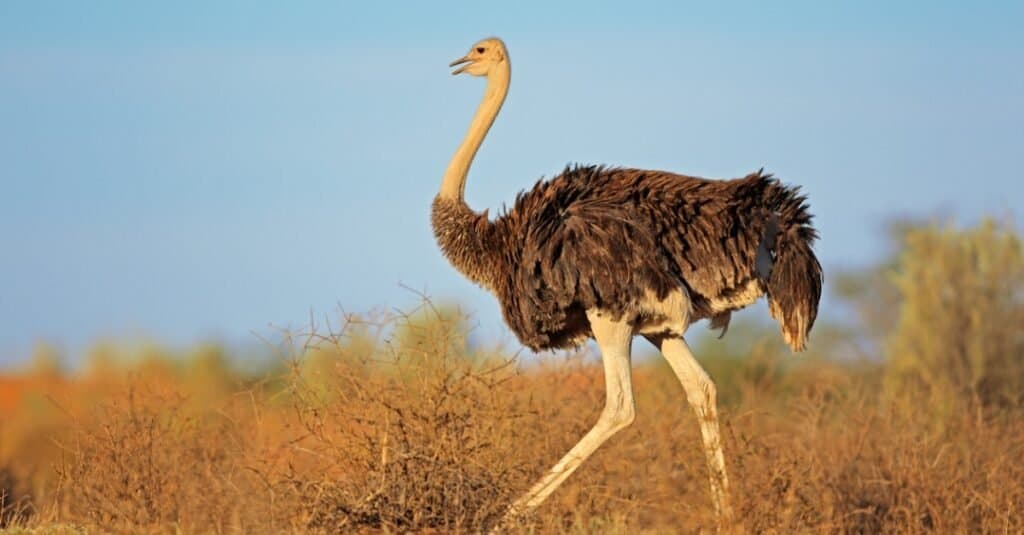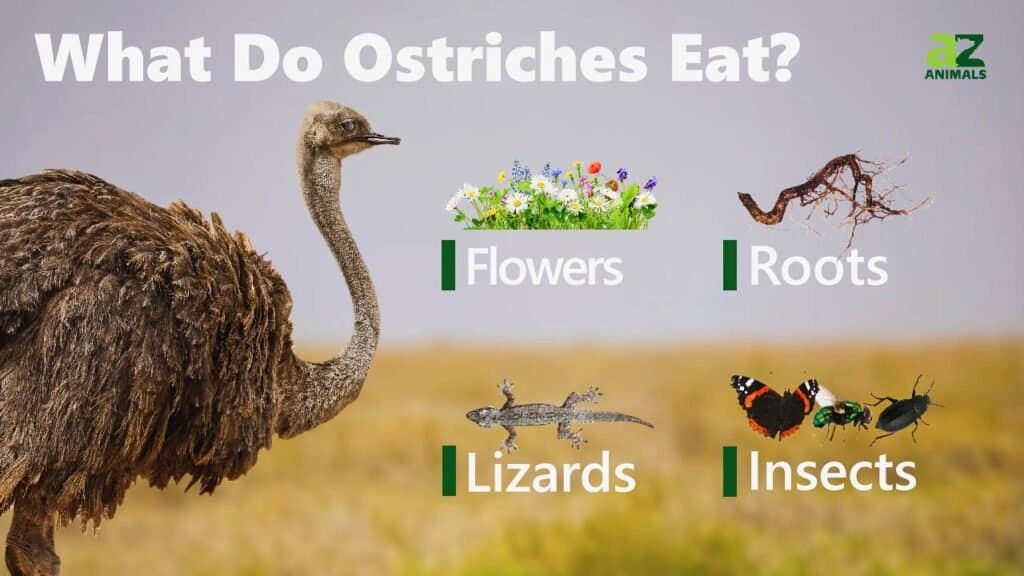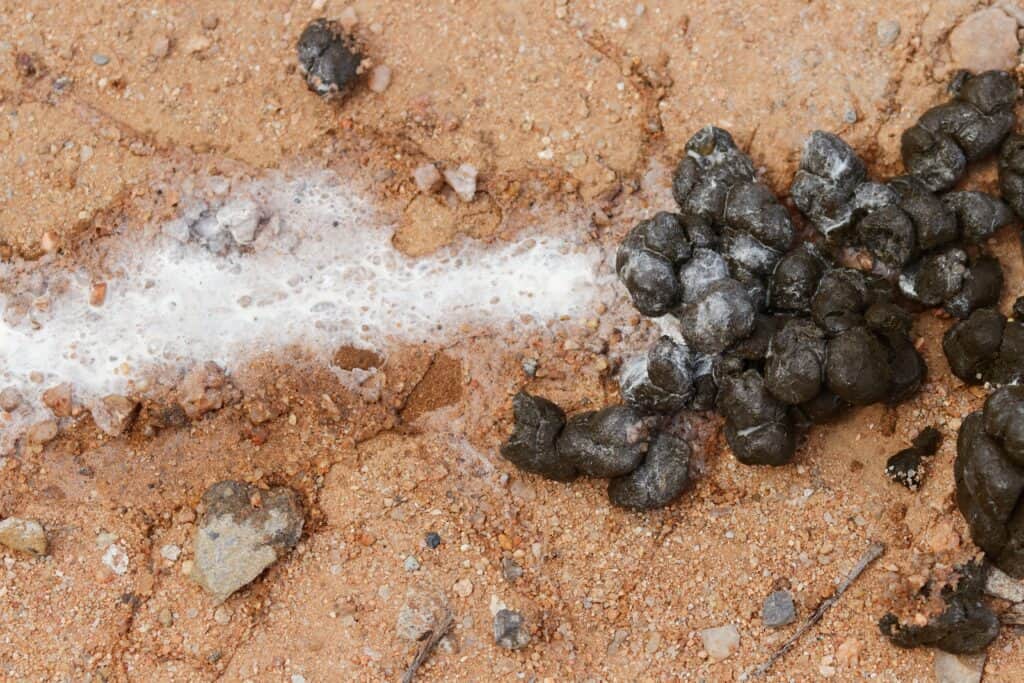Ostriches are the world’s largest birds! Their long necks and overall appearance suggest they may be related to dinosaurs. In any case, these animals have an incredibly rich history!
You’ve probably got acquainted with an ostrich at the zoo or on the road. Most likely, you’ve seen one poop right in front of you, right?! So now you may be wondering how they do that, what their waste consists of, and most importantly, what’s that weird thing coming out of their cloaca! Well, there’s nothing strange here, just anatomy for us and survival for ostriches. Check out this article to find the answers to these questions!
Are ostriches prehistoric animals?

The earliest
Struthiofossils date from the early Miocene.
©Cristian Zamfir/Shutterstock.com
The ostrich genus is scientifically called Struthio, in the Struthioniformes order. The paleontological evidence says that the members of this order first appeared on Earth during the Early Eocene and lived in Europe, Asia, and North America. The earliest Struthio fossils date from the early Miocene, about 21 million years ago. They were found in Africa. During this period, these animals are believed to have moved across Eurasia. Who could’ve imagined that ostriches are among the few prehistoric animals still alive?
Their appearance produced many theories, supposing that ostriches evolved from dinosaurs, specifically Ornithomimosaurs. However, this hasn’t been scientifically proven yet.
Ostrich appearance and habitat

Ostriches are the largest birds in the world.
©iStock.com/EcoPrint
Ostriches are the largest birds in the world, with males standing up to 9 feet tall and weighing as much as 287 pounds. On the other hand, females are smaller – measuring up to 6 feet high and weighing as much as 242 pounds.
An ostrich’s skin can be gray or pink. These birds have long, thin necks and legs that aren’t covered in feathers. Their heads are also featherless.
Although they are called birds, ostriches can’t fly. They still have their wings, however! Why do they have them then, right?! Scientists believe that ostriches’ wings and tails help them maintain their balance.
Ostriches prefer living in woodlands, savannas, and deserts. They are endemic to Africa. The Somali ostrich is common in the Horn of Africa.
What do ostriches eat, and what eats ostriches?

Ostriches are omnivorous animals. However, they primarily eat flowers, berries, grass, seeds, shrub or bush leaves, and nuts. Besides these, ostriches ingest sand and rocks that help digest their food. Sometimes they feed on tortoises, insects, rodents, lizards, snakes, or frogs.
Although ostriches are big animals, they, too, have predators. These birds are prey to cheetahs, leopards, and lions. However, since ostriches can move at high speeds (their top speed is 43.5 mph), most animals don’t stand a chance if they see one on the move. To catch an ostrich, they’d need to ambush it.
What does ostrich poop look like?

Ostrich poop can sometimes come out in numerous tiny, round excrements, usually of dark color.
©Beate Wolter/Shutterstock.com
Ostrich poop can be of various forms and shapes, depending on what they eat. Their waste can sometimes come out in numerous tiny, round excrements, usually of dark color. Other times, ostrich excrements consist of fewer, larger masses. If the ostrich primarily feeds on seeds and grasses, these will be visible in its waste, giving it an odd appearance.
How do ostriches digest food?
An ostrich’s digestive system resembles any other bird’s digestive system, except that it doesn’t have a crop where it can store its food. Other than that, the food it delights in passes through approximately the same digestive steps.
Here’s what an ostrich’s digestive system consists of:
- The proventriculus, which is also called the glandular stomach;
- The ventriculus, which is also called the gizzard;
- The small intestine;
- The caecum (the first part of the large intestine), which measures approximately 28 inches;
- The colon, which is also called the large intestine; a study shows that the African ostrich has a 33-foot-long colon connecting the ileum (the last part of the small intestine) with the cloaca
- The cloaca, where pee and poop come out from.
How many stomachs do ostriches have?

Ostriches have two stomachs – a proventriculus and a ventriculus.
©iStock.com/slowmotiongli
Like other birds, ostriches have two stomachs – a proventriculus and a ventriculus. The proventriculus, also called the glandular stomach, secretes gastric juices and plays a crucial role in food digestion. The ventriculus, also called the gizzard, may contain small stones that the ostriches ingest to help grind the food. Because ostriches don’t chew their food, they need help from the gizzard. Other animals that have organs resembling gizzards include earthworms.
Do ostriches pee and poop?
Some birds pee and poop at the same time through their cloaca. However, this is not the case with ostriches. They do not have urinary bladders.
A study shows that the ostrich’s urine is stored in the proctodeum – a part of the cloaca (the other part is called a coprodeum). The proctodeum act as a bladder. This proctodeum usually has a diameter of 0.39-0.78 inches when it’s empty and can reach 2.3-3.1 inches when it’s full (results are based on an 8-week-old ostrich). The scientists then observed the ostrich excreting the urine first and then the feces. That’s what makes the ostrich unique among other birds. Most other birds store the urine in the coprodeum, where they store the feces, too, and pee and poop simultaneously.
Incredible ostrich facts
- Unlike other birds, male ostriches have a retractable copulatory organ measuring 8 inches long that comes out when they pee or poop.
- Ostriches lay the largest eggs ever! Their eggs can be as large as a US dollar bill.
- Ostriches have only two toes! Other birds have three or four.
- Ostriches can live without drinking water for up to two weeks! That’s because they hydrate from the plants they eat!
- The eyes of the ostrich are probably the largest among birds and even mammals! Each eye measures approximately 2 inches in diameter. It’s also believed that their eyes are bigger than their brains!
- Ostrich’s breeding “system” is fascinating! Males are known to perform courtship dances and sensual moves to conquer an ostrich female. When the male is ready to mate, its neck becomes red. When the female is ready to mate, its feathers will become silvery.
The photo featured at the top of this post is © John Michael Vosloo/Shutterstock.com
Thank you for reading! Have some feedback for us? Contact the AZ Animals editorial team.






